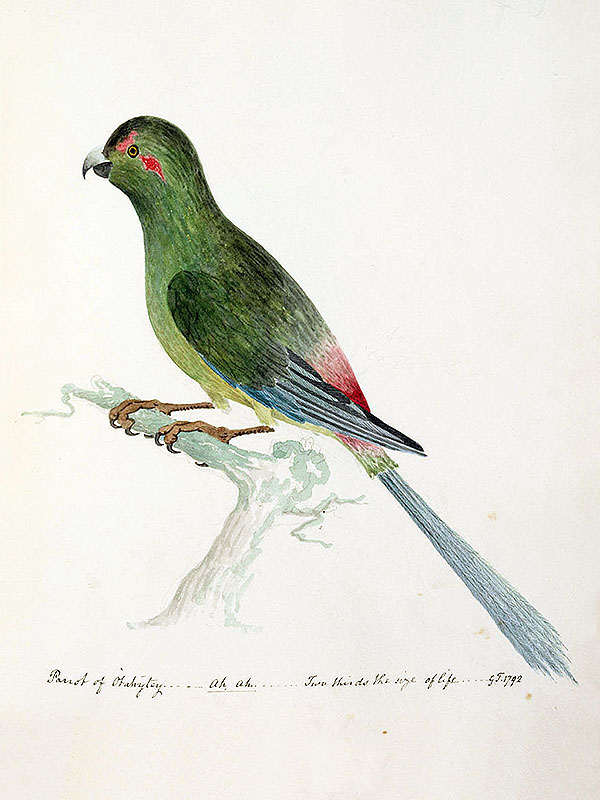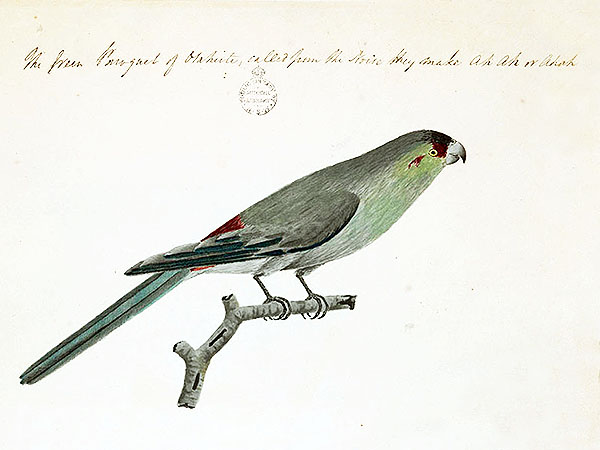… some thoughts about my favorite parrot genus – Cyanoramphus, I think about them very often …. 😉
***
„28.* Cyanoramphus erythronotus.
…
Society Is.: Tahiti and Raiatea (Forster)“ [1]
and
„30.* Cyanoramphus ulietanus.
…
?Ulietea or Raiatea, Society Islands (Lath.). – ?Tanna, New Hebrides (Bullock Coll. Brit. Mus.).
If the Parrot, P. ulieteanns Gm., really came from Ulietea as stated by Latham, it may prove to be the young of P. pacificus Forst. = erythronotus Kuhl.“ [1]
***
Number 28., the Black-fronted- or Tahiti-Parakeet is now named as Cyanoramphus zealandicus (Latham), what if the two species, the black-fronted and the Society Islands Parakeet, where indeed only one species?
The Black-fronted Parakeet appears to be very much like the remainder of the Cyanoramphus species, more or less completely green, with bluish wing feathers, and some red feathers behind the eye, but the other species, the Society Islands Parakeet, has a completely different coloration, being brownish olive-colored with a completely blackish head, it is completely unlike any of ist congeners.
The dull form may indeed have been the juvenile of the green one, yet all other species in the genus lack a special juvenile plumage, the young birds look exactly like the adult ones, and the only two known specimens of the Society Islands Parakeet appear to be adult birds – so no, this theory is invalid.
***
The origin of the two species is another question, it is not that much for certain, that in historical times one was found only on the island of Tahiti and the other one only on Ra’iatea, let alone the prehistorical times …! The only thing absolutely for sure is that the Black-fronted Parakeet indeed inhabited Tahiti.
Can you still follow me?
The genus is very rich in species in New Zealand and occurs there almost everywhere with at least two sympatrical species, and even as much as three on the large South Island (Yellow-fronted Parakeet (Cyanoramphus auriceps), Orange-fronted Parakeet (Cyanoramphus malherbi), Red-fronted Parakeet (Cyanoramphus novaezealandiae)).
So why should the island of Tahiti not have harbored two species as well? And why should these two species not have occurred on other islands within the Society archipelago as well? We will probably never know that for sure.
***
There are still so many mysteries surrounding this genus, one is the very disjunct distribution, with giant gaps of which one was only recently filled with the discovery of subfossil remains on the island of Rapa, Austral archipelago.
But this is another story for another day. 🙂
*********************
References:
[1] Lionel K. Wiglesworth: Aves polynesiae: a catalogue of the birds of the Polynesian subregion (not including the Sandwich Islands). Berlin: R. Friedlaender & Sohn 1891 In: Abhandlungen und Berichte des Königl. Zoologischen und Anthropologisch-Etnographischen Museums zu Dresden Bd. 3: 1-84. 1890/91. herausgegeben von Hofrath Dr. A. B. Meyer, Director des Museums
*********************
edited: 24.10.2018



